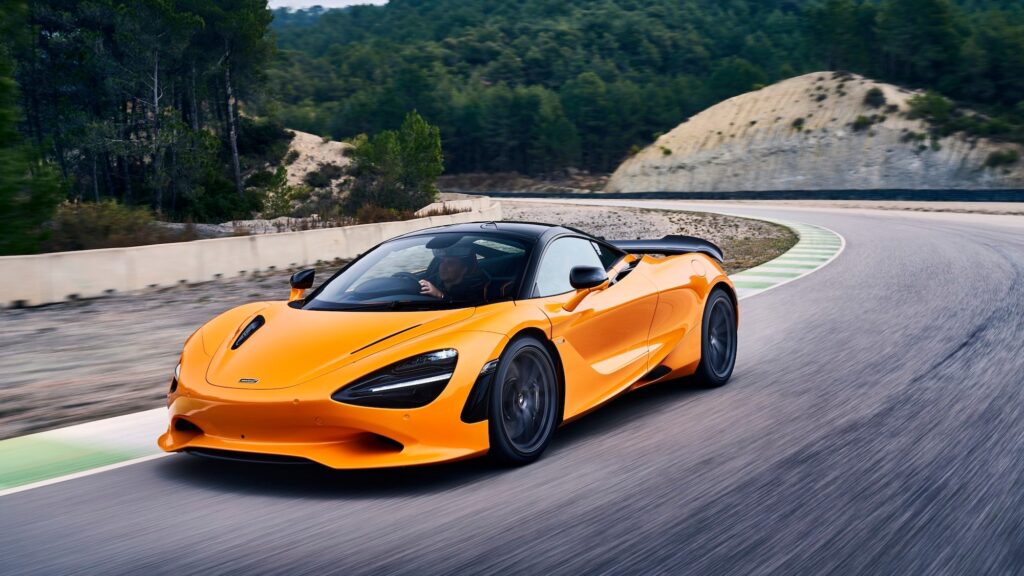Richard Nsubuga, the McLaren expert who gave me a run through of the controls of the 750S super car I was about to test drive, obviously saw the fear in my eyes. “Don’t worry, you’ll get used to it,” he said.
Super sportscars like the 750S can inspire trepidation as much as excitement. When you climb into the ridiculously low-slung driver’s seat and realise that 4 litres of twin-turbo V8 power and 740bhp are at your command, it can be just a little awe-inspiring.
Easing out from the Dubai Autodrome garage where I’d picked it up, just a small nudge on the gas pedal caused a shocking amount of acceleration; overtaking on the chaos of the Hessa Street freeway was exhilarating, but also downright scary.
Richard was right though. Midway through the all-too-short weekend test I lost my anxiety about the car – and began to seriously enjoy it.
One young man walked into a lamp-post as he was videoing me on Abdullah Omran Taryam Street
After 24 hours of swanking around Dubai, with the fluorescent orange car drawing admiring looks at every turn (one young man walked into a lamp-post as he was videoing me on Abdullah Omran Taryam Street), I began to feel comfortable with the vehicle.
Confirmation of its huge influencer power came at the late-night valet entrance in DIFC Gate Village, where I and my wife were fast-tracked to the front of the long line to get into Zuma, presumably because we had pulled up in such a sensational vehicle.
But the 750S is not just a car to be seen in. It is also an incredibly sophisticated drive, and could be a very important element in the Arabian Gulf’s strategy of high-technology investment.
That big powerful engine, coupled with an ultra-light carbon fibre body, translates into exceptional performance.
You can get from a standing start to 100km per hour in 2.7 seconds and reach a top speed of 330km/h. I cannot begin to imagine how that would be; when I nudged it over 140km/h on a stretch of the E11 it was how I imagine a fighter jet would feel on take-off.
The jet analogy is especially appropriate in the driver’s compartment, where you sit, or virtually lie, in a surprisingly comfortable bucket seat that makes you feel all safe and cocooned.
Very firm steering and suspension gives you confidence that the car will hold its line even at high speeds on tight turns – much like the F1 cars that McLaren has been successfully making for decades.
I was especially impressed by the elegant simplicity of the driving position. In an era when elite car manufacturers appear determined to fill every available space with buttons, dials and touch-pads, the 750S is thankfully free of those baubles, going instead for functional yet sophisticated technology on the dashboard lay-out and steering wheel.
There are, of course, a range of options to change drive mode, as well as the “Kiwi button” (in honour of New Zealander Bruce McLaren who founded the company 60 years ago) which customises all aspects of the drive.
The one that I tested was a “spider” version which had a retractable roof, which would be great in Dubai winters, but meant there was simply no space at all behind the front two seats. All your luggage goes in the “frunk” between the front wheels.
That compact arrangement means you are right on top of the engine and can sample up close the distinctive McLaren “tiger roar” as you accelerate fast. It really is an experience.
All that elaborate technology is the main reason investors from Abu Dhabi paid an undisclosed sum to buy the road-car business last year. CYVN is a government-owned investor in “advanced mobility” which is aiming to “transform McLaren into a high-performing British automotive business on the global stage,” I was told.
Specific plans to achieve that, after years of financial underperformance, will be revealed later this year. Maybe an SUV version is on the cards? That would be a sure-fire winner in the Gulf.
I do hope McLaren resists the temptation to go electric, which has proved a challenging proposition for elite sports car manufacturers, as witnessed by Ferrari’s recent decision to hold off production of its second all-EV model.
I mean, what’s the point of going through all that fear and trepidation if you cannot hear the tiger roar of McLaren’s internal combustion engine?
Frank Kane is Editor-at-Large of AGBI and an award-winning business journalist. He acts as a consultant to the Ministry of Energy of Saudi Arabia



